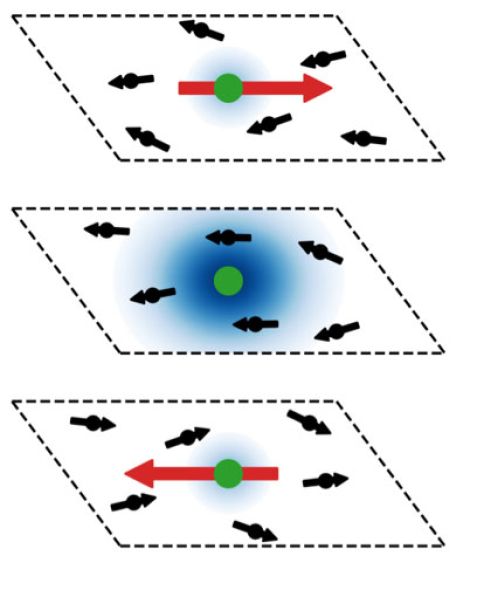MLZ is a cooperation between:
 > Technische Universität München
> Technische Universität München > Helmholtz-Zentrum Hereon
> Helmholtz-Zentrum Hereon
 > Forschungszentrum Jülich
> Forschungszentrum Jülich
MLZ is a member of:
 > LENS
> LENS > ERF-AISBL
> ERF-AISBL
MLZ on social media:

MLZ (eng)
Lichtenbergstr.1
85748 Garching
23.04.2018
Tunable quantum material interfaces for highly adaptive electronics

A graphic of a spontaneously emerging interface in a quantum material is shown. In the top and bottom layers, the atoms (green dots) of the investigated material carry a magnetic moment (red arrow) that points in opposing directions. In these layers, these magnetic moments are not correlated with the surrounding electrons (black dots). The centre layer is akin to an electronic interface, in which the atoms do not carry magnetic moments because they are screened by the magnetic moments of the surrounding electrons (black arrows). The screening effect is highlighted by a blue screening cloud. The scattering of the electrons off the atoms is different in the magnetic and non-magnetic layers which may be exploited for novel functionalities. © David Fobes, Marc Janoschek / Los Alamos National Laboratory
An international team of researchers has discovered functional electronic interfaces in quantum materials that can spontaneously self-assemble.
Device engineering could profit from this discovery that was made thanks to theoretical modeling combined with extensive neutron spectroscopy measurements at a number of leading research institutions, amongst them the Heinz-Maier-Leibnitz Zentrum (MLZ) in Garching, where Forschungszentrum Jülich operates an outstation of the Jülich Centre for Neutron Science (JCNS). “If we can learn to control and exploit the remarkable properties at the interfaces of quantum materials, this will likely result in a new generation of devices beyond our current imagination”, emphasized Dr. Marc Janoschek, a physicist at Los Alamos National Laboratory who led the international research team.
Materials with properties characterized by the laws of quantum mechanics rather than classical mechanics often display properties such as superconductivity. At interfaces between two materials, the remarkable properties of quantum materials can be strongly enhanced or entirely new functional properties may arise. Because quantum materials are chemically much more complex compared to “conventional” materials such as semiconductors, it remains a challenge to fabricate clean quantum material interfaces. The researchers provide a solution to this challenge by making use of the complexity of quantum materials, which is often characterized by various interactions competing at the quantum level.
Investigating a prototypical quantum metal, CeRhIn5, by means of neutron scattering, the team demonstrated the spontaneous formation of a quantum state in which the electronic and magnetic properties alternate at regular intervals. This periodic arrangement leads to interfaces between alternating material layers that are akin to interfaces in engineered heterostructures. However, the spontaneously self-assembling interfaces identified in this study have major advantages: they are intrinsically clean, and relevant parameters such as the interface thickness can be tuned in-situ via external parameters such as the magnetic field or temperature.
Precise knowledge of the so-called “magnetic structure” of this quantum metal was an important prerequisite for developing the theoretical models and understanding the quantum materials. Here magnetic structure refers to the spatial arrangement and the strength of the singular magnetic moments (the spins) carried out by the atoms in the crystal lattice. Very contradictory results had been previously reported in the literature. However, Janoschek had observed that most of the previous results were obtained using low-energy neutron radiation which undergoes strong absorption in certain materials. Notably, in CeRhIn5 the elements Rh and In both strongly absorb neutrons. “The re-investigation of the magnetic structure of CeRhIn5 using hot neutrons and absorption-optimized samples to exclude this potential source of uncertainty was crucial to our results”, reports Dr. Vladimir Hutanu from RWTH Aachen University. He is the head instrument scientist at the most modern of the very few instruments worldwide that provide such neutron beams, the single crystal diffractometer POLI at the MLZ. The instrument is operated in collaboration with Forschungszentrum Jülich and RWTH Aachen “Using the data from the POLI measurements, a clear picture of the magnetic structure in this complex material could be obtained, which served as valuable input for further research.”
(Text: Angela Wenzik / JCNS)
MLZ is a cooperation between:
 > Technische Universität München
> Technische Universität München > Helmholtz-Zentrum Hereon
> Helmholtz-Zentrum Hereon
 > Forschungszentrum Jülich
> Forschungszentrum Jülich
MLZ is a member of:
 > LENS
> LENS > ERF-AISBL
> ERF-AISBL
MLZ on social media:


